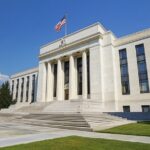
For the third meeting in a row, the Federal Reserve’s Federal Open Market Committee (FOMC) made the call that their best course of action was to do nothing with interest rates, a developing trend as the Committee also chose to hold rates steady at 5.50% at their last two meetings.
The most aggressive series of rate hikes in history ended in June when the committee held off on raising rates due to a litany of positive factors which consisted of 11 straight rate hikes over 15 months. Since the post-pandemic rate hikes began, the FOMC raised rates in March 2022 (+25 points), May 2022 (+50 points), June 2022 (+75 points), August 2022 (+75 points), September (+75 points), November 2022 (+75 points), December 2022 (+50 points), February 2023 (+50 points), March 2023 (+25 points), May 2023 (+25 points), June 2023 (+0 points), July (+25 points), September (+0 points), November (+0 points), and December (+0 points). This is equivalent to a rise of 5.00 percentage points in under two years.
This string of rate hikes that have occurred since the pandemic has been necessary according to the FOMC to tamp down inflation, which reached a high of 9.1% in June 2022. While inflation has eased, it is still above the committee’s target rate of 2%. However, the Fed now predicts that inflation will not come down to their 2% target until sometime in 2026.
The target rate now stands at 5.25-5.50%. The committee next convenes for its first meeting of 2024 on Jan. 30-31, 2024.
In a prepared statement released at the end of the meeting, the FOMC said:
“Recent indicators suggest that growth of economic activity has slowed from its strong pace in the third quarter. Job gains have moderated since earlier in the year but remain strong, and the unemployment rate has remained low. Inflation has eased over the past year but remains elevated.”
“The U.S. banking system is sound and resilient. Tighter financial and credit conditions for households and businesses are likely to weigh on economic activity, hiring, and inflation. The extent of these effects remains uncertain. The Committee remains highly attentive to inflation risks.”
“The Committee seeks to achieve maximum employment and inflation at the rate of 2% over the longer run. In support of these goals, the Committee decided to maintain the target range for the federal funds rate at 5.25% to 5.50% percent. The Committee will continue to assess additional information and its implications for monetary policy. In determining the extent of any additional policy firming that may be appropriate to return inflation to 2% over time, the Committee will take into account the cumulative tightening of monetary policy, the lags with which monetary policy affects economic activity and inflation, and economic and financial developments. In addition, the Committee will continue reducing its holdings of Treasury securities and agency debt and agency mortgage-backed securities, as described in its previously announced plans. The Committee is strongly committed to returning inflation to its 2% objective.”
“In assessing the appropriate stance of monetary policy, the Committee will continue to monitor the implications of incoming information for the economic outlook. The Committee would be prepared to adjust the stance of monetary policy as appropriate if risks emerge that could impede the attainment of the Committee’s goals. The Committee’s assessments will take into account a wide range of information, including readings on labor market conditions, inflation pressures and inflation expectations, and financial and international developments.”
Also at the end of the meeting, a number of highly-placed and well-respected economists made comments on the news, including Michele Raneri, VP of U.S. research and Consulting at TransUnion, who said:
“With today’s announcement of a continuation of the pause on interest rate increases by the Fed, it is hopeful that we are one step closer to an eventual reduction in interest rates. A reduction in interest rates could not only help in stimulating the mortgage origination market, but could also provide an opportunity for millions of consumers who have recently taken on high interest mortgages to refinance and see significant impacts to their monthly budgets.”
“As reported in last month’s Q3 2023 TransUnion Credit Industry Insights Report, mortgage originations are down nearly 37% year-over-year, from 1.9 million in Q2 2022 to 1.2 million in Q2 2023. While this plateauing of interest rates may be enough to motivate some consumers who have been holding off to engage in the mortgage market, many may continue to wait until the Fed ultimately reduces interest rates.”
“In addition, we expect those homeowners who are currently making payments on high interest mortgage loans to be among the first to take advantage of a reduction in rates as refinancing could immediately put real money into their pockets. In fact, since January 2021, there have been three million new mortgages originated with interest rates of 6% of higher, the total balance of which being over $1 Trillion. The monthly payments of each of these high interest mortgages averages $2,201.”
“If interest rates dropped to even 5.5%, it could result in significant savings for these homeowners, as refinancing at that rate could result in an average monthly payment of $1,917 for them, a reduction of $284 every month. This would represent nearly three hundred dollars a month that these homeowners would be able to use elsewhere in this continued high cost-of-living environment in which every dollar counts.”
A&D Mortgage CEO Max Slyusarchuk on the FOMC’s recent announcement to hold steady on interest rates and what this means for home buying.
“We project that we are at the end of the period when the Fed will raise interest rates. In other words, this is the beginning of mortgage rates beginning to slowly decline through 2024. However, we don’t expect rates to fall that much in this period and it may not offset rising home prices in hot housing markets. So, homebuyers who wait on the sidelines for better rates next year may find the waiting game didn’t pay the dividends they expected.”
Realtor.com Chief Economist Danielle Hale also commented, saying the following:
“The Federal Reserve’s Open Market Committee (FOMC), the rate-setting body that meets roughly eight times per year, is expected to vote to hold the short-term policy rate steady at a range of 5.25% to 5.50%. Despite an uptick in hiring and drop in the unemployment rate in November, the bigger trend has tended toward slowing labor market momentum. Similarly, the latest consumer price index data shows that overall inflation slowed even though core inflation remains stubbornly high. On balance, the Fed has made progress against inflation and the policy stance remains restrictive. I expect the Fed to acknowledge that the risks around whether current policy is restrictive enough are now more balanced.”
“In the press conference following the November meeting, Chair Powell noted that the Committee was looking to build confidence in the idea that policy was restrictive enough. Markets suggest that investors are already confident in this outcome. Financial conditions have eased since the FOMC last gathered, with the benchmark 10-year treasury yield dipping from 4.8% to 4.2% in the inter-meeting period. At the same time, futures markets are pricing in a higher likelihood of more rate hikes by the end of 2024. The Fed will weigh in, publishing its Summary of Economic Projections, which could show a lower median expectation for the Fed Funds rate at the end of 2024 which was 5.1% in September.”
“Mortgage rates have mirrored the easing in longer-term rates. The widely quoted Freddie Mac mortgage rate index, which hovered just below 8% at the time of the last FOMC meeting, now sits just above 7%. While this improvement has mortgage rates at their lowest level since August, the last time mortgage rates consistently exceeded this threshold was 20+ years ago. In other words, despite improvement, mortgage rates remain high and while potential buyers bear the brunt of higher rates, many would-be sellers note the sharp difference between current rates and the all-time lows under 3% reached just three years ago.”
“I anticipate that the Fed will celebrate the progress made to date on inflation, and while it will highlight the need to remain vigilant against inflation, I expect that the Fed’s projections for 2024 will continue to anticipate a normalization in monetary policy in the year ahead. This is in line with Realtor.com’s 2024 Housing Forecast, which expects that mortgage rates will continue to ease in 2024 as inflation improves and Fed rate cuts get closer. Mortgage rates could near 6.5% by the end of the year, a key factor in starting to provide affordability relief to homebuyers.”
Voting for the monetary policy action were Jerome H. Powell, Chair; John C. Williams, Vice Chair; Michael S. Barr; Michelle W. Bowman; Lisa D. Cook; Austan D. Goolsbee; Patrick Harker; Philip N. Jefferson; Neel Kashkari; Adriana D. Kugler; Lorie K. Logan; and Christopher J. Waller.





